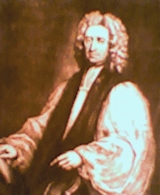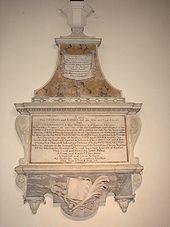
Edmund Gibson
Encyclopedia
Edmund Gibson was a British
divine and jurist.
, Westmorland
. In 1686 he was entered a scholar at Queen's College, Oxford. Shortly after Thomas Tenison
's elevation to the see of Canterbury
in 1694 Gibson was appointed chaplain and librarian to the archbishop, and in 1703 and 1710 respectively he became rector of Lambeth
and archdeacon of Surrey
.
, whence he was in 1720 translated to London
. For twenty-five years he exercised influence, being consulted by Sir Robert Walpole
on ecclesiastical affairs.
While a conservative in church politics, and opposed to Methodism
, he was no persecutor, and indeed broke with Walpole on the Quakers' Relief Bill of 1736. He exercised oversight over the morals of his diocese; and his denunciation of the masquerades which were popular at court finally lost him the royal favour. He served as a founding governor of a charity called the Foundling Hospital
. His endorsement can be seen as significant since the Foundling Hospital, created by royal charter
, was the nation's first non-church initiated institution to target this sort of social ill.
Gibson died in 1748, and is buried at All Saints Church, Fulham
, London.
 In 1691 he published an edition of the Saxon Chronicle
In 1691 he published an edition of the Saxon Chronicle
with a Latin
translation, indices and notes, and later a similar translation of the Lindsey Chronicle. These were followed in 1693 by an annotated edition of the De institutione oratoria of Quintilian
, and in 1695 by a translation in two volumes folio of Camden
's Britannia, with additions and improvements, in the preparation of which he had been largely assisted by William Lloyd, John Smith and other English antiquaries.
In the discussions which arose during the reigns of William
and Anne
relative to the rights and privileges of the Convocation
, Gibson took a very active part, and in a series of pamphlets warmly argued for the right of the archbishop to continue or prorogue even the lower house of that assembly.
The controversy suggested to him the idea of those researches which resulted in the Codex juris ecclesiastici Anglicani, published in two volumes folio in 1713, a work which discusses more learnedly and comprehensively than any other the legal rights and duties of the English clergy, and the constitution, canons and articles of the English Church.
Among the literary efforts of his later years the principal were a series of Pastoral Letters in defence of the gospel revelation, against lukewarmness and enthusiasm, and on various topics of the day; also the Preservative against Popery, in 3 vols. folio (1738), a compilation of numerous controversial writings of eminent Anglican divines, dating chiefly from the period of James II
.
A second edition of the Codex juris, revised and improved, with large additions by the author, was published at Oxford in 1761. Besides the works already mentioned, Gibson published a number of Sermons, and other works of a religious and devotional kind. The Vita Thomae Bodleii with the Historia Bibliothecae Bodleianae in the Catalogi librorum manuscriptorum (Oxford, 1697), and the Reliquiae Spelmannianae (Oxford, 1698), are also from his pen.
British people
The British are citizens of the United Kingdom, of the Isle of Man, any of the Channel Islands, or of any of the British overseas territories, and their descendants...
divine and jurist.
Early life and career
He was born in BamptonBampton, Cumbria
Bampton is a village and civil parish in the Eden District of Cumbria, England, on the edge of the Lake District National Park. The parish had a population of 283 according to the 2001 census...
, Westmorland
Westmorland
Westmorland is an area of North West England and one of the 39 historic counties of England. It formed an administrative county from 1889 to 1974, after which the entirety of the county was absorbed into the new county of Cumbria.-Early history:...
. In 1686 he was entered a scholar at Queen's College, Oxford. Shortly after Thomas Tenison
Thomas Tenison
Thomas Tenison was an English church leader, Archbishop of Canterbury from 1694 until his death. During his primacy, he crowned two British monarchs.-Life:...
's elevation to the see of Canterbury
Archbishop of Canterbury
The Archbishop of Canterbury is the senior bishop and principal leader of the Church of England, the symbolic head of the worldwide Anglican Communion, and the diocesan bishop of the Diocese of Canterbury. In his role as head of the Anglican Communion, the archbishop leads the third largest group...
in 1694 Gibson was appointed chaplain and librarian to the archbishop, and in 1703 and 1710 respectively he became rector of Lambeth
Lambeth
Lambeth is a district of south London, England, and part of the London Borough of Lambeth. It is situated southeast of Charing Cross.-Toponymy:...
and archdeacon of Surrey
Surrey
Surrey is a county in the South East of England and is one of the Home Counties. The county borders Greater London, Kent, East Sussex, West Sussex, Hampshire and Berkshire. The historic county town is Guildford. Surrey County Council sits at Kingston upon Thames, although this has been part of...
.
Episcopal career
In 1716 Gibson was presented to the see of LincolnBishop of Lincoln
The Bishop of Lincoln is the Ordinary of the Church of England Diocese of Lincoln in the Province of Canterbury.The present diocese covers the county of Lincolnshire and the unitary authority areas of North Lincolnshire and North East Lincolnshire. The Bishop's seat is located in the Cathedral...
, whence he was in 1720 translated to London
Bishop of London
The Bishop of London is the ordinary of the Church of England Diocese of London in the Province of Canterbury.The diocese covers 458 km² of 17 boroughs of Greater London north of the River Thames and a small part of the County of Surrey...
. For twenty-five years he exercised influence, being consulted by Sir Robert Walpole
Robert Walpole
Robert Walpole, 1st Earl of Orford, KG, KB, PC , known before 1742 as Sir Robert Walpole, was a British statesman who is generally regarded as having been the first Prime Minister of Great Britain....
on ecclesiastical affairs.
While a conservative in church politics, and opposed to Methodism
Methodism
Methodism is a movement of Protestant Christianity represented by a number of denominations and organizations, claiming a total of approximately seventy million adherents worldwide. The movement traces its roots to John Wesley's evangelistic revival movement within Anglicanism. His younger brother...
, he was no persecutor, and indeed broke with Walpole on the Quakers' Relief Bill of 1736. He exercised oversight over the morals of his diocese; and his denunciation of the masquerades which were popular at court finally lost him the royal favour. He served as a founding governor of a charity called the Foundling Hospital
Foundling Hospital
The Foundling Hospital in London, England was founded in 1741 by the philanthropic sea captain Thomas Coram. It was a children's home established for the "education and maintenance of exposed and deserted young children." The word "hospital" was used in a more general sense than it is today, simply...
. His endorsement can be seen as significant since the Foundling Hospital, created by royal charter
Royal Charter
A royal charter is a formal document issued by a monarch as letters patent, granting a right or power to an individual or a body corporate. They were, and are still, used to establish significant organizations such as cities or universities. Charters should be distinguished from warrants and...
, was the nation's first non-church initiated institution to target this sort of social ill.
Gibson died in 1748, and is buried at All Saints Church, Fulham
All Saints Church, Fulham
All Saints Church, Fulham is an Anglican Church in Fulham, London sited close to the river Thames, beside the northern approach to Putney Bridge.-History:...
, London.
Works

Anglo-Saxon Chronicle
The Anglo-Saxon Chronicle is a collection of annals in Old English chronicling the history of the Anglo-Saxons. The original manuscript of the Chronicle was created late in the 9th century, probably in Wessex, during the reign of Alfred the Great...
with a Latin
Latin
Latin is an Italic language originally spoken in Latium and Ancient Rome. It, along with most European languages, is a descendant of the ancient Proto-Indo-European language. Although it is considered a dead language, a number of scholars and members of the Christian clergy speak it fluently, and...
translation, indices and notes, and later a similar translation of the Lindsey Chronicle. These were followed in 1693 by an annotated edition of the De institutione oratoria of Quintilian
Quintilian
Marcus Fabius Quintilianus was a Roman rhetorician from Hispania, widely referred to in medieval schools of rhetoric and in Renaissance writing...
, and in 1695 by a translation in two volumes folio of Camden
William Camden
William Camden was an English antiquarian, historian, topographer, and officer of arms. He wrote the first chorographical survey of the islands of Great Britain and Ireland and the first detailed historical account of the reign of Elizabeth I of England.- Early years :Camden was born in London...
's Britannia, with additions and improvements, in the preparation of which he had been largely assisted by William Lloyd, John Smith and other English antiquaries.
In the discussions which arose during the reigns of William
William III of England
William III & II was a sovereign Prince of Orange of the House of Orange-Nassau by birth. From 1672 he governed as Stadtholder William III of Orange over Holland, Zeeland, Utrecht, Guelders, and Overijssel of the Dutch Republic. From 1689 he reigned as William III over England and Ireland...
and Anne
Anne of Great Britain
Anne ascended the thrones of England, Scotland and Ireland on 8 March 1702. On 1 May 1707, under the Act of Union, two of her realms, England and Scotland, were united as a single sovereign state, the Kingdom of Great Britain.Anne's Catholic father, James II and VII, was deposed during the...
relative to the rights and privileges of the Convocation
Convocation
A Convocation is a group of people formally assembled for a special purpose.- University use :....
, Gibson took a very active part, and in a series of pamphlets warmly argued for the right of the archbishop to continue or prorogue even the lower house of that assembly.
The controversy suggested to him the idea of those researches which resulted in the Codex juris ecclesiastici Anglicani, published in two volumes folio in 1713, a work which discusses more learnedly and comprehensively than any other the legal rights and duties of the English clergy, and the constitution, canons and articles of the English Church.
Among the literary efforts of his later years the principal were a series of Pastoral Letters in defence of the gospel revelation, against lukewarmness and enthusiasm, and on various topics of the day; also the Preservative against Popery, in 3 vols. folio (1738), a compilation of numerous controversial writings of eminent Anglican divines, dating chiefly from the period of James II
James II of England
James II & VII was King of England and King of Ireland as James II and King of Scotland as James VII, from 6 February 1685. He was the last Catholic monarch to reign over the Kingdoms of England, Scotland, and Ireland...
.
A second edition of the Codex juris, revised and improved, with large additions by the author, was published at Oxford in 1761. Besides the works already mentioned, Gibson published a number of Sermons, and other works of a religious and devotional kind. The Vita Thomae Bodleii with the Historia Bibliothecae Bodleianae in the Catalogi librorum manuscriptorum (Oxford, 1697), and the Reliquiae Spelmannianae (Oxford, 1698), are also from his pen.

